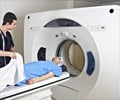A new magnetic resonance imaging (MRI) technique has been developed by a team of researchers at the University of British Columbia, which may help detect signs of multiple sclerosis more vividly

Multiple sclerosis (MS) occurs when a person's immune cells attack the protective insulation, known as myelin, that surrounds nerve fibres. The breakdown of myelin impedes the electrical signals transmitted between neurons, leading to a range of symptoms, including numbness or weakness, vision loss, tremors, dizziness and fatigue.
 | ||||
Source-Eurekalert













